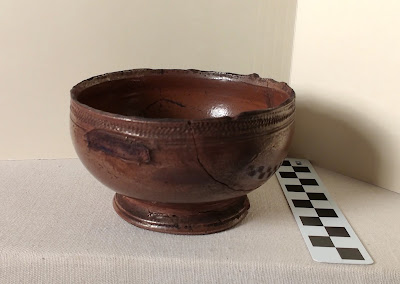 |
| Nottinghamware bowl. Stoneware, c. 1666 |
I consulted Patricia Stamford, director of the Maryland Archaeological Conservation Lab, who examined photos of the bowl. She writes, "I would say that you do have the lower half of a Nottingham stoneware loving cup. The top edge of the piece appears to be rough in places, suggesting that the piece was broken at some point and then probably lovingly evened off to make a footed bowl."
Nottinghamware was salt-glazed brown stoneware made in Nottingham, England, from the late 1600s until the early 1800s. “Salt glazing” is just what it sounds like: during kiln firing, salt is introduced into the kiln, where it reacts with the clay to create a shiny, pitted glaze that makes brown stoneware look a bit like bronze. Nottinghamware was quite fine stoneware. This bowl is evenly thin, not thick and clunky like some more utilitarian pieces.
Many 17th-century New England colonists owned ceramics imported from Europe. Along with locally-made pottery, a typical Massachusetts household might have had pieces from Holland, Spain, England, Portugal, and even China. England continued to import stoneware to the colonies until the end of the Revolutionary War.
We'll never know how or when this loving cup came to be broken, or who decided to give it a second life as a bowl. But I like to imagine Hannah Battle and her new husband, more than 350 years ago, sharing their first drink as a married couple from the cup.
While you look, you might like to listen to the Rolling Stones' "Loving Cup" (1972).





